Contributions Fall 2020
Testing for SARS-CoV-2: a massive breakthrough for ensuring access to LMICs
On September 28, 2020 the diagnostic pillar of the ACT-A led by the Foundation for Innovative New Diagnostics (FIND) and the Global Fund announced a full access package that includes WHO policy guidance on the use of antigen-based rapid diagnostic tests, manufacturer volume guarantees for low and middle-income countries, catalytic funding to assist governments to deploy the tests and an initial US$50 million procurement fund. The Global partnership will make available 120 million affordable, quality COVID-19 rapid tests for low- and middle-income countries. This is the latest move from the Access to COVID-19 Tools (ACT) Accelerator to develop, procure and distribute critical new tools to fight the pandemic. New tests are urgently needed to meet the huge unmet needs for testing worldwide.
The announcement has four main points:
The WHO issued a policy guidance on the use of antigen-based rapid diagnostic tests. Several rapid, point-of-care antigen tests are being assessed by WHO for Emergency Use Listing (EUL)
The ACT-A diagnostics partnership has reach an agreement with two test manufacturers Abbott and SD Biosensor make available innovative tests priced at a maximum of US$5. 20% of the overall production will be reserved for low- and middle-income countries (LMICs).
The Global Fund commits an initial US$50 million to enable countries to purchase the new tests, with the first orders expected to be placed by the end of October.
Expedited market introduction of these tests in multiple LMICs is being supported through the Africa Centers for Disease Control and Prevention (Africa CDC), Unitaid, FIND, CHAI, and their partners
Access to the Press conference here:
https://www.who.int/emergencies/diseases/novel-coronavirus-2019
Investing in diagnostics R&D and manufacturing is complementary to similar interventions on vaccines and therapeutics.Until a vaccine has been developed and produced for global use, diagnostics are the most important medical technology available today to limit the spread of COVID-19. Testing the right people, at the right moment and with the right tool is critical to contain the COVID-19 crisis. Despite global efforts, significant gaps remain in R&D and access to testing, particularly for Low- and Middle-Income Countries (LMICs). Current estimates indicate that 500 million tests are needed over the next 12 months in low- and middle-income countries to enable such a life-saving scenario. The global challenge is therefore two-fold: to develop new rapid diagnostic tests and to scale up the production of such reliable, affordable tests.
Launched in early April 2020, the ACT-A Diagnostic Partnership gathers major global health actors engaged on normative and operational R&D and Access policies for medical products. FIND and the Global Fund are leading this initiative. The ACT-A Diagnostic Partnership (ACT-A Dx) activities led by Foundation for Innovative New Diagnostics (FIND) are focusing on:
Research and Development: accelerate development and availability of high performing, affordable rapid diagnostic tools, and create robust digital, data and analytics solution;
Market readiness: implement market shaping interventions to accelerate implementation including assessment of product performance, validation of use-cases, support for manufacturing and commercialization, price negotiation, and in-country prioritization and regulatory support;
Supply: identification of supply availability, demand aggregation and ensure efficient logistics and delivery, and
Country capacity building: strengthen health systems and build country capacity and preparedness for rapid and effective test implementation.
Until today, the following countries have pledged funding: United Kingdom, Switzerland, Germany. Saudi Arabia, The Netherlands , Australia and Kuwait. The diagnostic pillar is critically underfunded: Out of $3.1bn pledges to ACT-A, 9% are dedicated to diagnostic pillar. USD 2 billion is required immediately to harness innovation globally and secure access to vital diagnostic tests for low- and middle-income countries.
Links to related resources
SDC Assistant Director Christian Frutiger delivered a video message on the very same topic at a side event of the United Nations General Assembly on September 30.
https://access-for-all.world-television.com/playlist/23954752/featured/128089133/english
Find more information here:
FIND: testing is the first line of defense:
https://www.finddx.org/testing-matters/
The Global Fund COVID operational response:
https://www.theglobalfund.org/en/covid-19/
WHO Emergency Use Listing for In vitro diagnostics (IVDs) Detecting SARS-CoV-2:
https://www.who.int/diagnostics_laboratory/200922_eul_sars_cov2_product_list.pdf?ua=1
Contact
Olivier Praz
Senior Policy Advisor & Health Focal Point, SDC
In-country activities
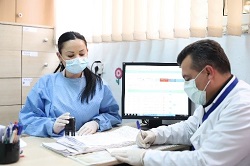
Revised clinical protocols and guidelines on non-communicable diseases soon to be available for teams of family medicine
In Albania NCDs are estimated to account for about 93% of total deaths, with cardiovascular diseases being the main culprit (57% mortality rate)[1] . NCDs have been subject to significant growth over the past two decades, a trend that is expected to continue in the future because of increasing life expectancy and aging of the Albanian population.
A significant proportion of these diseases can be managed and controlled at the primary healthcare level, in the most cost-effective way and without requiring hospitalization or hospital treatment. A steady increase in the number of cases treated by the PHC services is noted, especially for hypertension and diabetes. Therefore, there is an immediate need for revised and comprehensive clinical protocols and guidelines (CPGs) on NCDs given the fact that current clinical protocols are either not utilized or outdated, PHC professionals are not fully involved in the process, and training is rarely organized to support the guidelines or protocols implementation[2].
In response to these issues, the SDC project Health for All (HAP) has initiated the revision of the existing clinical guidelines and protocols (CGP) for the five most frequent NCDs PHC services deal with, namely: asthma, chronic obstructive pulmonary disease, diabetes, hypertension, and dyslipidemia. Prior to the revision process, HAP supported the elaboration of an inventory of existing CPGs on NCDs for PHC teams, as a useful database and starting point for further work.
The revision of CPGs as an iterative process is carried out by a working group composed of family doctors and specialist physicians in PHC through an inclusive and participatory approach. The focus of this process is developing updated clinical guidelines and protocols as educational and practical tools for each of the above-mentioned diseases. The novelties of this process are related to the development of the treatment protocols as algorithm, remote consultation quick guide, roles of the family medicine team members in managing NCDs, indicators to monitor internally and externally the implementation of CGP and the Training Manual to capacitate the FM teams in making use of them at everyday practice. Once approved by the Albanian health authorities, the documents will be disseminated and training on their use will be provided to family doctors and nurses working in PHC via Training of Trainers and Peer Group CME approaches
[1] “Non-communicable diseases-Country Profiles",
WHO, 2018
[2] “Strategy for the development of PHC services in Albania 2020-2025",
Ministry of Health and Social Protection
Contact
Irma Qehajaj
Communication Officer at Health for All Project
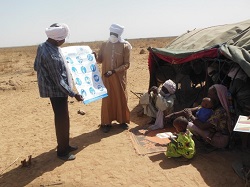
Shared benefits of One Health vaccination campaigns for nomadic families
During May to August in 2020, three joint human and animal vaccination campaigns for nomadic children, women, and their camp livestock were conducted in the districts of Korbol and Alifa, in the regions of Moyen Chari and Batha respectively. An important feature of these joint campaigns is that they were organized and implemented with local health and veterinary personnel. Through this combined approach, duplication of effort was avoided and the use of all existing personnel and infrastructure (cold chain and transportation means) was maximized. These and planned future joint campaigns are supported by the Swiss Tropical and Public Health Institute (Swiss TPH) together with the Centre de Support en Santé Internationale (CSSI) as part of One Health activities of the PADS – 'Programme d'Appui aux Districts Sanitaires' project (https://www.pads-tchad.org).
The results of the 2020 joint campaign efforts were very successful. After three visits from the vaccination team, over 4000 children (<5 years of age) were fully immunized according to the routine vaccination schedule; and 625 women received at least 2 doses of tetanus vaccine (TT2+). At the same time, veterinarians vaccinated 5,619 livestock against anthrax and pasteurellosis, 2,880 against contagious bovine pleuropneumonia and 983 against small ruminant pest. This achievement is a clear example of how interdisciplinary efforts can be both resource-sensitive and optimize the health of humans, animals, and their shared livelihoods.
As part of the recent vaccination campaigns conducted within PADS, the opportunity was taken to show and discuss pictograms incorporating COVID-19 health and sanitary messages with nomadic community members. This was done before vaccinations were given by trained community-based facilitators who further reinforced this messaging through their use of precautionary measures (wearing masks, physical distancing) whilst doing their work.
Evidence of being able to take this action at this time is important to highlight because in the wake of the COVID-19 pandemic, national immunization programmes are globally at risk of disruption due to severe health system constraints [1]. Further, deaths prevented by sustaining routine childhood immunization in Africa outweigh the excess risk of COVID-19 deaths associated with vaccination clinic visits, especially for the vaccinated children [1]. It therefore remains indispensable to sustain routine childhood immunization programmes, particularly for the already hard-to-reach populations.
The proven success of the One Health interdisciplinary vaccination campaigns offers a viable long-term solution for those currently facing zoonotic or human disease outbreaks and those wanting to prevent them in future. To support the capitalisation of this experience, the PADS team are organizing training workshops in November 2020 to support district teams in adopting the implementation of mixed vaccination campaigns and animal-human health surveillance activities.
[1.] Abbas K, Procter SR, van Zandvoort K, Clark A, Funk S, Mengistu T, Hogan D, Dansereau E, Jit M, Flasche S, Houben RMGJ, Edmunds WJ, Villabona-Arenas CJ, Atkins KE, Knight GM, Sun FY, Auzenbergs M, Rosello A, Klepac P, Hellewell J, Russell TW, Tully DC, Emery JC, Gibbs HP, Munday JD, Quilty BJ, Diamond C, Pearson CAB, Leclerc QJ, Nightingale ES, Liu Y, Endo A, Deol AK, Kucharski AJ, Abbott S, Jarvis CI, O'Reilly K, Jombart T, Gimma A, Bosse NI, Prem K, Hué S, Davies NG, Eggo RM, Clifford S, and Medley G: Routine childhood immunisation during the COVID-19 pandemic in Africa: a benefit & risk analysis of health benefits versus excess risk of SARS-CoV-2 infection. The Lancet Global Health 2020; 8(10):e1264-e1272.
Contact
Dr Abdelmadjid Abderahim
Program Officer, Swiss Cooperation Office in Chad
abdelmadjid.abderahim@eda.admin
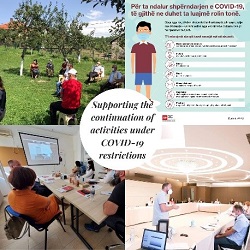
Kosovo
Supporting the continuation of activities under COVID-19 restrictions
Continuing Community Outreach in COVID-19 pandemic times
AQH has quickly adapted its community outreach strategy for people with higher risk of severe COVID-19 disease such as patients with NCDs.
Continuous provision of local populations with timely and accurate information on improving diabetes and hypertension care during this crisis is essential to prevent disease aggravation. AQH health education sessions for those at higher risk for severe illness took therefore place in an open environment under specific restrictions where possible. In parallel the project intensified the use of social media to share information
Social Media role on informing individuals living with NCDs
The AQH social media campaign in close collaboration with Ministry of Health and National Institute of Public Health for the past months focused on disseminating relevant information to people living with NCDs. This included: self-management strategies, the importance of uninterrupted access to their medication supply, their increased risk from COVID-19, the importance of everyone taking the right actions to protect those at higher risk. Social media are a well-accepted communication channel for Kosovo citizens and health professionals alike. AQH social media sites have reached more than 1milion people since April 2020.
Health Management Trainings for Main Family Medicine Centre's managers
Interactive and participatory training events were a well-appreciated contribution of AQH in the past. Under Covid-19 restrictions, AQH transformed its management training component entirely into an on-line format whilst maintaining a high level of interactivity and frequent training events. The project has successfully launched training for 70 health managers from 12 municipalities in Kosovo since the start of the pandemic.
Increasing health management capacities on project municipalities, empowering managers to better respond to the COVID-19 crisis through improved planning of PHC services and health resource management represents the first two modules of training package that were delivered to date.
Motivational Counselling Training on times of COVID
Twelve participants from the project municipalities have participated on Motivational Counselling training sessions while all the necessary safety precautions to protect from COVID-19 were taken into account.
The trained nurses will support and encourage patients with non-communicable diseases as diabetes and hypertension to reduce unhealthy habits and use strategies for coping with COVID-19 while focusing on the things they can control.
An alternative approach has been introduced involving use of the telemedicine, and more importantly engagement of nurses to deliver the diabetes/hypertension care; by providing real time audio consultations through phone for up to 400 patients in 5 pilot municipalities.
Further resources
https://www.facebook.com/AQHproject/
Contact
Merita Stavileci, Senior National Programme Officer
Swiss Cooperation Office in Kosovo
merita.stavileci@eda.admin.ch
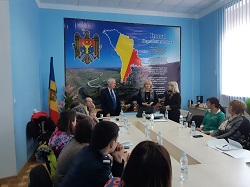
Moldova
Creating a vision of Integrated Care among decision-makers
Since January 2019, the
Healthy Life Project in partnership with representatives from Health and Social Sectors have started to develop a model of integrated community care. This is based on the WHO Integrated People Centred Health Services (IPCHS) concept, and aims to support people with long-term conditions.
The key feedback from implementation is generally positive with people and workforce open to new approaches and clear that integration could be done through mobilisation of existing resources. To facilitate this evolution, the webinar was set up to focus on the different building blocks with participants drawing attention to the need for more capacity building (training of community nurses and social workers) and of community teams to include local public authorities, other sectors, NGOs, formal and informal carers and volunteers. There is also a need to strengthen the regulatory basis and to introduce clearer roles and responsibilities, especially in regards to disease prevention /health promotion.
Falesti district team indicated during the webinar: “We confirm that the integration of services at community level adds value to our work, including, to ensure the management of the situation related to COVID 19. All community actors are involved in identification and promptly referral of cases to the health system, and as well in making the link to other sectors and systematically monitoring the situation of children and their families.
Invited international speakers, Dr. Viktoria Stein and Mandy Andrews from VM Partners Integrating Health and Care, gave an input at the Webinar on the building blocks needed to develop, support and sustain integrated care: cultures and values, governance and accountability, continuous improvement, competencies, care transitions and processes, information flows and data, communication, community involvement and person-centeredness.
“Integrated care is a concept centred around the needs of service users with services organized around the needs of the population."
The webinar connected experts in Chisinau and in the 3 districts, with VM Partners and Swiss TPH. Agreed next steps include: looking more closely at staff wellbeing, capacity building for multidisciplinary teams, enhancement of the community nurse role, striving towards more integrated planning, functional and organizational co-producing and coordination, making use of communication and dissemination platforms
Related resources
WHO Europe. EUR/RC66/15 Strengthening people-centred health systems in the WHO European Region: framework for action on integrated health services delivery. Copenhagen: WHO Regional Office for Europe, 2016.
http://www.euro.who.int/en/health-topics/Health-systems/pages/publications/2016/eurrc6615-strengthening-people-centred-health-systems-in-the-who-european-region-framework-for-action-on-integrated-health-services-delivery
WHO 2015. People-centred and integrated health services: an overview of the evidence. Geneva, World Health Organisation 2015.
https://www.who.int/servicedeliverysafety/areas/people-centred-care/evidence-overview/en/
Goodwin N, Stein V, Amelung V. What is integrated care? in Amelung VE, Stein KV, Goodwin N, Balicer R, Nolte E, Suter E (editors). Handbook Integrated Care. New York, Springer Nature, 2017.
Nolte E, Pitchforth E. What is the evidence on the economic impacts of integrated care. Copenhagen: WHO Regional Office for Europe and European Observatory on Health Systems and Policies, 2014.
Cameron A, Lart R, Bostock L, and Coomber, C. Factors that promote and hinder joint and integrated working between health and social care services: a review of research literature. Health Soc Care Community. 2014 May; 22(3):225-33. doi: 10.1111/hsc.12057.
Kadu MK and Stolee P. Facilitators and barriers of implementing the chronic care model in primary care: a systematic review. BMC Fam Pract. 2015 Feb 6;16:12. doi: 10.1186/s12875-014-0219-0.
Authors
Tatiana Dnestrean and Ala Curteanu, Healthy Life Project
Manfred Zahorka Swiss Tropical and Public Health Institute
Main project contact
Valeriu Sava
National Program Officer in Health, Representation of the Embassy of Switzerland to Moldova
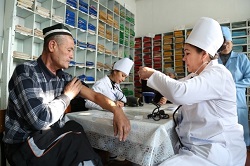
Tajikistan
Endline survey into out of pocket (OOP) expenditures for health care
The public health expenditure to GDP ratio has remained low in Tajikistan and the population has no choice but to seek healthcare through payments from their own pocket. An endline survey was conducted in 2019 by the Swiss TPH through SDC's “Enhancing Primary Health Care Services Project" and compared to the previous survey conducted in 2016. It was designed as a cross-sectional community based survey and conducted in 8 districts. The respondents were adult patients that had visited a health centre in the previous 3 months.
Between 2016 and 2019 the project has been involved in community engagement work to build greater health literacy and understanding of the right to health. Communication materials related to the Basic Benefits Package and the fees that can be legitimately charged by a PHC facility have been prepared and widely disseminated.
From the total 1,600 interviewed respondents (majority women (88.3%) and of median age 31 years old). The main reason for visiting a family doctor was pregnancy (44.9%); other highly reported reasons included cardiovascular (25.9%), respiratory (15.6%), acute digestive (15.0%) and genitourinary (12.5%) problems and diabetes (14.8%). Eighty two percent of respondents reported the prescription of medicines during the last consultation and from those, every fifth patient (20.8%) received five prescriptions or more. Among the prescriptions were a high number of injections and almost half received an antibiotic.
Forty-two percent reported to have paid money on a formal basis at an average cost of 3.2 USD. The majority of patients reported formal fees for the diagnostic tests, however about 15% reported payment for the consultation itself. Giving money on an informal basis to the family doctor was reported by 23.9% with a mean amount of 1 USD. Even though the rate of informal payments have increased since 2016 (15.6%), the frequency of informal payments is only half of what was reported in the much earlier iterations of the survey in 2005 and 2011. In 2019, of all study participants, 80.2% have spent money for medicine, at a mean amount of 9.2 USD. The high rate of polypharmacy and the type of prescriptions continue to drive these high medicine expenditures.
These medicine expenditures are also drivers of inequality: patients with chronic conditions pay far more than other patients, and patients of higher social economic status (SES) seem to be able to afford better/more medicines than patients of lower SES. Medicine prescription patterns and the high rate of polypharmacy, antibiotics and injections require urgent attention. Community engagement and improvement of transparency remain further important factors allowing patients to act on their own agency to demand fair and quality treatment.
Authors
Dr. Gulara Afandiyeva, Head of Swiss TPH Representative office Dr. Gulzira Karimova, National Project Coordinator
Ms. Fabienne Fischer, Swiss TPH
Main contact
Dr. Muazamma Dzhamalova,
National Program Officer Health, Swiss Cooperation Office in Tajikistan
muazamma.dzhamalova@eda.admin.ch

Member interviews
What we learned from Health Shareweb users
To improve the usefulness of the Health Shareweb and our quarterly newsletter, we recently had to opportunity to conduct 16 interviews with Health network members from the SDC and partner organizations. The results help us to keep doing what’s good and to inject new content and formats ideas to offer additional value.
The status quo - Key documents and useful news updates
The overall value of the shareweb for most interviewees lies in its character as an online repository for key documents around SDC's work in the health area, such as strategic documents and the indicator list. Multiple interviewees find that the Shareweb offers a good collection of information and that the regular news serve as very useful pin pointer to other relevant sources of information.
Additional topics, a stronger focus on work in partner countries and with NGOs, and additional links to research – Suggestions for content of the shareweb, news posts and newsletter
While one interviewee expressed the wish that other topic areas could be covered, such as Digital Health, Partnerships and the collaboration of SDC with NGOs in the field, another interviewee was interested in having a dedicated page for knowledge sharing between local projects – possibly linked to the official SDC project database. Others wished more ample content around the fields of scientific research linked our work (i.e. culture and behavioral change, determinants of health) reflections on the SDC's work (agenda, strategies, COVID-19 response) and articles on ongoing global debates.
Small adjustments – Formats of the shareweb and news posts
While the overall format of the shareweb is very well received by most, some found that certain key documents should be more easily accessible.
The format of the news post was valued by some as easily accessible through the short abstracts, while others thought the addition of visuals could add value.
The quarterly newsletter is perceived as very useful by most, although some mentioned that it tends be rather long. More video content is perceived by many as a good way to make information easily accessible.
Focused navigation, a space for regional exchanges, video series and punctual online events - Conclusion and new ideas for the Health network facilitation
Based on the overall feedback we were able to receive; we are looking to implement a series of measures that shall contribute to adding value to the Health Shareweb:
an exercise to simplify the navigation of the shareweb and to presenting the most relevant content more prominently
explore options to include more content on the shareweb and newsletter on local collaborations with NGOs, the work of SDC and social sciences
explore options to create focus area pages on the shareweb for better knowledge management and exchange between local projects
explore options for video series on…
foster interactive discussions and webinars with targeted information to share ideas and views
explore possibilities to create short videos to explain main points of new reports and documents
being more inclusive with language: more articles in French and calls for contributions in French to stimulate participation
Do you have ideas for other content and formats?
Please contact lou.curchod@eda.admin.ch
Knowledge products
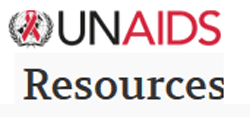
Applying the human rights lens to dealing with a pandemic -Lessons learnt from the HIV/AIDS response
As the COVID-19 pandemic is now at the forefront of public health concerns and responses, it is important to remember that we are yet on an ambitious schedule to fight the HIV-pandemic and have done so with some great success during the past decades. UNAIDS is currently reviewing evidence and consulting stakeholders at all levels to draft a new strategy to fight and eliminate HIV/AIDS as a public health threat by 2030. SDC is closely following this process and is engaged at the multilateral level.
To reach key populations with prevention measures, diagnostics and treatment still remains a challenge in each country in 2020. At the basis of this challenge lie not only resource and quality constraints, but also questions around acceptability and access to services, including from a legal und human rights perspective.
While the COVID-19 pandemic aggravates the above mentioned gaps, civil society and international organisations and states have gained a lot of experience in the past decades with the HIV/AIDS response, one of many key lessons being that any approach to such a pandemic must be human rights based in order to reach everyone, be successful and sustainable.
The key message is thus to learn from best practices in terms of policy work and legal frameworks, be it for current HIV- or COVID-19 responses.
UNAIDS has recently made available two new resources:
- A new HIV Policy Lab online platform went online on 29th September. It systematically gathers and monitors laws and policies adopted by countries around the world—documenting where key HIV science has been translated into policy. It is an open, growing global public resource that builds data from legal documents, government reporting, and independent research. The HIV Policy Lab is a collaboration between academic, UN, and civil society organizations to track, measure and improve the HIV-related law and policy environment in countries around the world.
https://www.hivpolicylab.org/
- With the financial support of SDC, lessons learnt on human rights based approaches have been capitalized and published in 8 case studies. You find them on the
UNAIDS website or in the
health network library.
Contact
Corinne Corradi, Senior Advisor
Sexual & Reproductive Health and Rights / Global Health, SDC
